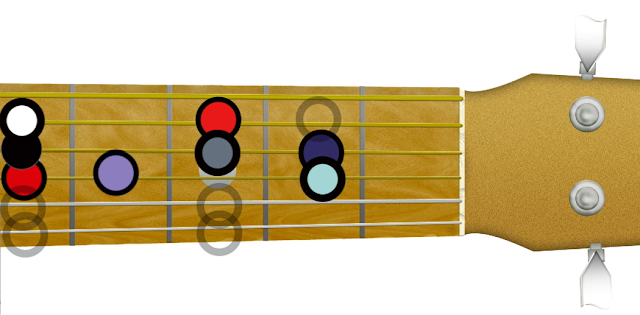In lesson 9, we looked at the A shape on the fretboard, which can be used to play any major chord.
In this lesson, you are going to build on this knowledge and learn how:
- the A shape pattern is linked to the C shape
- to solo with the A shape if your root note is on the 5th string
- to find the other interval notes within the major scale when using the A shape
When we play the C shape, we use our little finger (or ring finger) on the root note. This frees up the fingers to the left to play the other notes we need.
In this A shape pattern, we're going to play the same root note, but we're going to use our index finger. This frees up the fingers to play on the right hand side of it.
Now we can find a 3rd interval note and a 5th interval note to build this into any major chord, using the A shape.
We have a fifth interval note on the fourth string. It's two frets down, and two frets across from our root note. We looked at this interval pattern in lesson 6, finding fifth intervals.
Directly below our fifth interval note, we have another octave note. We also looked at this interval pattern in lesson 6, finding fifth intervals.
Directly below this octave note on the third string, we have a third interval note. We looked at this octave patter in lesson 5, on how to find third interval notes to create harmony.
Soloing with the A shape
Starting on our root note, we can walk up all 7 notes in our A shape, by finding them mainly to the right of the fret that the root note is in.
So, our 2nd interval note is now two frets up, still on the fifth string (white dot on the fifth string).
Our third interval note, we know we play on the string below our root and to the left one fret (dark purple dot on the fourth string).
Our fourth interval note we know is found directly below our root (dark grey dot on the fourth string).
Our perfect fifth, we can find one string down, and two frets across (black dot on the fourth string).
Our 6th interval we find directly below our third (light blue dot on the third string).
Our seventh interval note is found in the fret before our octave note (light purple dot on the third string).
So, if you want to solo over a major chord that has its tonal centre on this fifth string, you can put the root note under your index finger, and use this pattern.
Guitar practice journal
Download the Guitar Practice Tracker today. It will help to keep you motivated and give you a visual representation of your progress, and areas of focus throughout the year.
A guitar journal will enable you to:- Set personalised goals and monitor your progress
- Identify the number of hours or days you've spent on a particular skill
- Provide a quick reference to the notes and chords in a particuar key
- List the songs you know and sort by key, capo placement, artist, and chord progression
- Link directly to your favourite YouTube videos and tutorials
Download the Guitar Practice Tracker
If you found this lesson helpful and you're able to, please


